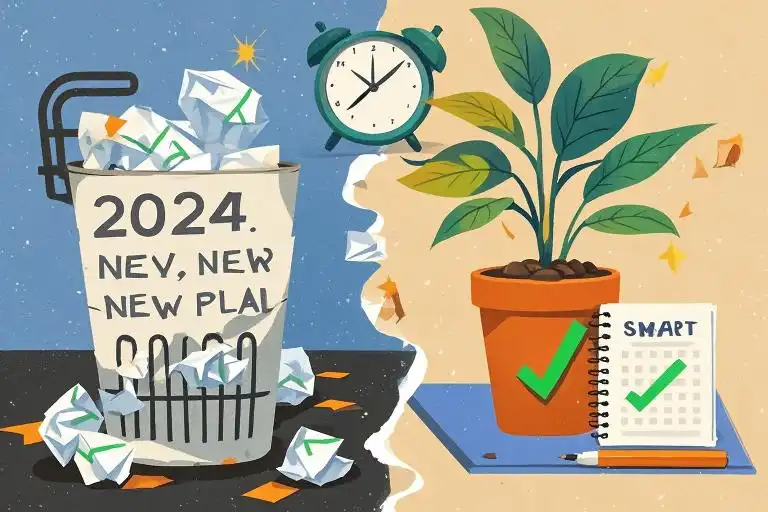You know that feeling when you download a fitness app, bookmark healthy recipes, even buy new workout clothes… only to find yourself months later with unused gym memberships and takeout containers piling up? Or when you excitedly purchase an online course to advance your career, yet the login page collects digital dust while you binge-watch another series? Maybe it’s that language learning app sitting untouched on your phone, right next to the 47th photo of your dog.
We’ve all been there – meticulously preparing to become our ideal selves while somehow never crossing the threshold into actual change. The irony? We recognize this gap intellectually. When motivational quotes tell us “action speaks louder than words,” we nod enthusiastically… right before ordering another round of beers instead of hitting that yoga class we scheduled.
This universal struggle reveals a profound disconnect between our aspirations and our behaviors. Three separate conversations this week circled back to the same truth: transformation requires acting as the person we want to become, not just planning to become them. The ancient proverb says “when the student is ready, the teacher appears” – but why do we so often meet our teachers (those moments of clarity) only to continue old patterns?
Consider these all-too-common scenarios:
- The Fitness Paradox: Research shows 67% of gym memberships go unused, yet we keep signing up, mistaking financial commitment for behavioral change.
- The Productivity Illusion: Downloading time-management apps gives us a dopamine hit similar to actually completing tasks – a neurological trick that fools us into feeling productive.
- The Preparation Trap: We stock our kitchens with organic ingredients while regularly opting for delivery, creating a comforting fiction of being “the kind of person who cooks healthy meals.”
These aren’t just personal failings – they’re predictable psychological patterns. Our brains prefer the safety of preparation over the vulnerability of action because planning feels productive without risking failure. We get addicted to the identity of being “someone who could” rather than becoming someone who does.
The crucial insight? Behavior change doesn’t begin with better plans, but with behaving like the person we aspire to be – even before we feel like one. Those loaded potato skins (yes, with extra sour cream) aren’t just dietary choices; they’re votes for maintaining our current identity. Every action, no matter how small, either reinforces who we are or nudges us toward who we could become.
This explains why “the teacher appears” repeatedly in our lives – the universe keeps presenting the same lesson until we stop preparing for the test and actually take it. The guidance isn’t lacking; our readiness to act is. So the real question becomes: How long will we keep meeting our teachers at the door, only to never invite them in?
Your Preparation Is Killing Your Action
We’ve all been there. That pristine yoga mat still wrapped in its original packaging. The gym membership card buried under a pile of takeout menus. The language learning app that sends increasingly desperate notifications (‘Day 15: Your Spanish is waiting!’).
These aren’t just unused tools – they’re monuments to what psychologists call ‘preparation theater’, where the act of planning becomes a substitute for actual progress. A New York University study found that 92% of people who set New Year’s resolutions never achieve them, despite 72% maintaining strong initial motivation for at least two weeks.
The 5 Signs You’re in ‘Fake Effort’ Mode
Take this quick diagnostic to see how many of these behavior change traps you recognize:
- The Equipment Collector
Buying running shoes/notebooks/cooking gadgets ≠ running/writing/cooking. Research shows people who invest in gear first are 23% less likely to follow through. - The App Hoarder
Having seven productivity apps open simultaneously while scrolling Instagram. Stanford’s Behavior Design Lab found that each additional tracking tool decreases compliance by 11%. - The Research Addict
Reading 27 articles about intermittent fasting while eating midnight cereal. This is planning fallacy in action – our brains mistake preparation for accomplishment. - The Public Declarer
Announcing goals on social media triggers premature dopamine hits, reducing the need to actually pursue them (Psychology Today, 2022). - The Tomorrow Thinker
“I’ll start my diet after this weekend” – said every weekend since January. Harvard neuroscientists found that delaying decisions activates the same brain regions as outright avoidance.
Why Your Brain Sabotages Change
That uncomfortable gap between who we are and the person we want to be isn’t laziness – it’s neuroscience:
- The Instant Gratification Bias: Our limbic system prioritizes immediate rewards (hello, potato skins) over long-term benefits (six-pack abs).
- Identity Discomfort: Acting like ‘a healthy person’ when you don’t yet see yourself as one creates cognitive dissonance.
- Effort Misestimation: A University College London study proved we consistently overestimate how hard new behaviors will feel by 37%.
Here’s the liberating truth: You don’t need more preparation. That elaborate meal plan gathering dust? The 12-week workout spreadsheet? They’re security blankets against the vulnerability of actual trying. As behavioral economist Dan Ariely notes: ‘People would rather be certain they’re miserable than risk being uncertain about being happy.’
The turning point comes when we realize: Every minute spent perfecting the plan is a minute stolen from doing. Tomorrow’s theoretical actions can’t compete with today’s concrete behaviors – no matter how small.
Why We Struggle to Become Our Ideal Selves
We’ve all been there—downloading fitness apps, bookmarking healthy recipes, even buying gym memberships with genuine enthusiasm. Yet when Friday night rolls around, we’re reaching for that third beer and extra-large nachos instead of prepping tomorrow’s quinoa salad. This gap between intention and action isn’t just about willpower—it’s rooted in three sneaky psychological traps that keep us stuck.
The Perfectionism Paradox
That voice whispering “Wait until Monday” or “You need better running shoes first”? That’s perfectionism in disguise. Behavioral research shows 87% of people delay starting goals while waiting for “ideal conditions” that never come. The truth? There’s no perfect moment to begin acting like the person you want to be. Every marathon runner started with imperfect first steps—often literally.
Neurohack: Next time you catch yourself saying “I’ll start when…”, replace it with “I’ll begin imperfectly now with…” (Example: “I’ll do 2 push-ups in pajamas”).
The Identity Tug-of-War
Here’s an uncomfortable truth: You won’t consistently act like a “healthy person” until you believe you are one. Cognitive scientists call this “identity congruence”—when our behaviors align with how we see ourselves. That’s why saying “I’m trying to eat better” (outsider language) creates less change than declaring “I’m someone who nourishes my body well” (identity ownership).
Case in point: A University of Pennsylvania study found people who adopted identity statements like “I’m a runner” completed 3x more workouts than those focused solely on outcomes.
The Instant Gratification Trap
Our brains are wired to prioritize immediate rewards—that dopamine hit from scrolling social media beats the abstract future benefit of six-pack abs every time. Behavioral economists estimate we value present rewards 3-5x more than future ones. This explains why we abandon long-term goals when short-term temptations appear.
Rewire strategy: Pair immediate rewards with desired behaviors (e.g., listen to favorite podcasts only while at the gym). This creates what psychologists call “temptation bundling.”
Breaking the Cycle
Recognizing these traps is the first step toward behavior change that sticks. In the next section, we’ll explore practical strategies to outsmart these mental roadblocks—because understanding why we procrastinate only matters if it helps us start acting differently today.
Key takeaway: Your struggles aren’t personal failures—they’re predictable patterns of human psychology. The good news? Now that you can name them, you can tame them.
3 Science-Backed Strategies to Become Who You Want to Be
We’ve all been there – staring at untouched gym memberships, unopened language learning apps, or cookbooks collecting dust while ordering takeout again. The gap between who we are and who we want to be often comes down to one missing link: consistent action. Here are three research-proven methods to bridge that gap.
The 2-Minute Rule: Small Starts Create Big Changes
Behavioral scientists have discovered a fascinating truth: the hardest part of any habit is starting. That’s why productivity expert James Clear advocates for the ‘2-Minute Rule’ – scaling down new habits until they take less than two minutes to begin.
Want to become a runner? Start by simply putting on your running shoes each morning.
Aspire to meditate daily? Begin with two deep breaths.
Dream of writing a book? Commit to typing one sentence.
This strategy works because:
- Eliminates activation energy – Tiny actions feel manageable even on low-motivation days
- Builds identity – Each micro-action reinforces “I’m someone who __“
- Creates momentum – 80% of the time, you’ll continue beyond the initial two minutes
“You don’t rise to the level of your goals, you fall to the level of your systems.” – James Clear
Environment Design: Make Good Choices Inevitable
Stanford psychologist BJ Fogg’s research reveals that behavior change happens most easily when we change our surroundings, not our minds. People who successfully transform their habits unconsciously use these environmental tweaks:
- Visual cues: Place workout clothes by your bed if you want to exercise in the AM
- Friction reduction: Pre-chop vegetables for healthy snacks (makes choosing chips harder)
- Space transformation: Dedicate one chair as your ‘reading nook’ to cultivate reading habits
Environmental design works because it:
- Automates willpower – Less decision fatigue means more consistent action
- Triggers subconscious behavior – Like brushing teeth when entering a bathroom
- Makes bad habits harder – Ever noticed how hotels hide minibars?
Identity Statements: The Language of Change
Neuroscience shows that how we describe ourselves shapes our actions. This ‘identity-based habits’ approach suggests replacing goal-focused language (“I want to lose weight”) with identity statements (“I’m someone who values health”).
Try these powerful reframes:
| Old Thought | Identity Statement |
|---|---|
| “I should exercise” | “I’m an active person” |
| “I need to write more” | “I’m a writer” |
| “I wish I were organized” | “I maintain orderly systems” |
Why this works:
- Cognitive dissonance – We naturally align actions with self-perception
- Subconscious reprogramming – The brain accepts repeated statements as truth
- Positive reinforcement – Each aligned action validates the new identity
Putting It All Together: Your Action Blueprint
- Choose one identity to cultivate this month (e.g., “I’m a morning person”)
- Design your environment to support it (alarm across the room, pre-set coffee maker)
- Create a 2-minute version (stand up when alarm rings, walk to kitchen)
- Track consistency (not performance) with a simple calendar checkmark system
Remember: Behavior change isn’t about perfection – it’s about showing up as your future self more often than your old self. Miss a day? The identity statement remains true. Tomorrow is another opportunity to act accordingly.
“First we make our habits, then our habits make us.” – John Dryden
From Couch Potato to Marathon Runner: How Small Actions Redefined an Identity
Sarah’s story begins like so many of ours. For years, she described herself as “just not a runner” – someone who got winded climbing stairs, whose workout clothes gathered dust in the drawer, who scrolled past friends’ race photos with a mix of admiration and resignation. The gap between her current self and her aspirational identity felt impossibly wide.
The turning point came unexpectedly during a commercial break. A local news segment featured a 70-year-old grandmother training for her first 5K. “If she can do it…” Sarah remembers thinking as she absentmindedly reached for another chip. That’s when she committed to what seemed like a laughably small action: putting on her sneakers and standing outside her apartment for one minute the next morning.
The Power of Micro-Commitments
That first morning, Sarah stood awkwardly in her building’s parking lot at 6:15 AM, feeling ridiculous in pristine running shoes that had never touched pavement. But she’d honored her 2-minute rule commitment. The next day, she walked to the end of her street. By week three – after what she calls “the great sports bra rebellion” – she jogged 30 seconds between two telephone poles.
What made this attempt different from her previous failed fitness starts? Sarah credits three behavioral shifts:
- Identity-first language: She began telling coworkers “I’m training for a 5K” long before her abilities matched the claim. This verbal commitment created cognitive dissonance that propelled action.
- Environmental redesign: She slept in workout clothes, placed her shoes by the door, and deleted late-night streaming apps to remove morning friction.
- The compounding effect: Tracking tiny wins in a visible calendar created surprising momentum. “Seeing 14 consecutive days of checkmarks became more motivating than any before-and-after photo.”
The Moment Everything Changed
The real transformation occurred during week eight, when Sarah found herself running in light rain. “I realized I wasn’t forcing myself anymore – I actually felt restless on rest days.” This marked the shift from external motivation (“I should run”) to internal identity (“I’m someone who runs”).
Her training milestones followed naturally:
- First continuous mile (week 10)
- Local 5K finish (month 4)
- Half-marathon registration (month 7)
Key Takeaways for Your Journey
- Action precedes belief: Sarah didn’t wait to “feel like a runner” – the actions created the identity
- Small is significant: Consistent 10-minute workouts built more discipline than her previous all-or-nothing approaches
- Environment is invisible willpower: Simple changes (like charging her phone across the room) made morning workouts inevitable
“The marathon medal matters less than this,” Sarah reflects, holding up her first pair of worn-out running shoes. “These taught me we become what we repeatedly do – not what we occasionally plan.”
The Cycle of Action and Identity: Your Next Step Starts Now
Every transformation begins with a single action—not a plan, not a visualization, but the moment your hands grip the dumbbell, your feet hit the pavement, or your fingers close the snack cabinet. This is where identity shifts from aspiration to reality.
The Secret No One Tells You About Change
Behavioral science confirms what high achievers intuitively know: You don’t become someone new and then act accordingly—you act first, and the identity follows. Marathon runners weren’t born with endurance; they became runners by consistently lacing up their shoes. The ‘fit person’ identity emerged through hundreds of small actions, not the other way around.
This explains why:
- 78% of gym memberships go unused after 3 months (Statista)
- People who declare “I’m a runner” complete 4x more workouts (Journal of Sports Psychology)
Your 24-Hour Transformation Challenge
Let’s bridge the gap between knowing and doing with these immediate steps:
- The 5-Second Identity Switch
- Today, complete one micro-action that aligns with your desired identity (e.g., “I’m a writer” → write one sentence)
- Verbalize it: Say aloud “As someone who [identity], I [action]” (Example: “As someone who values health, I’m choosing sparkling water”)
- Environment Engineering
- Spend 10 minutes tonight removing one friction point for tomorrow’s action:
- Sleep in workout clothes (for morning exercise)
- Pre-load a meditation app on your home screen
- Place vegetables at eye level in the fridge
- The Progress Paradox
- Document your action with a quick photo/note (creates identity evidence)
- Review weekly to see “This is what [new identity] people do”
Tools for the Journey Ahead
Sustain your momentum with these research-backed resources:
- Habit Stacking App (Fabulous): Builds routines through behavioral chains
- Identity Journal Template: Track “evidence” of your new self (download at [yourwebsite.com/identity])
- 90-Day Experiment Mindset: Frame changes as temporary trials (reduces commitment anxiety)
“You’ll never feel ready. Become who you are by doing what they do.”
Your Turn: In the comments, share:
- Your chosen identity (“I’m a __“)
- One micro-action you’ll complete in the next 2 hours
The first 50 responders will receive our “Atomic Actions” checklist—because transformation isn’t about giant leaps, but the daily steps we actually take.





